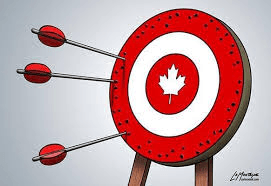Target Misses the Mark in Canada

In January 2015, Target announced that it would liquidate its operations in Canada, shut down all 133 stores and report a $5.4 billion loss for the quarter.
Limitless Potential
In late 2010, Target indicated that it would, for the first time, open stores outside of the US with an expansion in to Canada. The Canadian economy weathered the 2008 recession with relative ease and consumer spending was robust and growing.
Following Walmart’s successful entrance in to the Canadian market, Target was convinced that its premium yet budget friendly product offering would appeal to the cost conscious as well as the fashionably inclined. Target’s brand was already well recognized by Canadians who often shopped at Target stores south of the border.
Assuming the Canadian marketplace was similar to the US and that customers buying behavior was unlikely to be significantly different, Target started with a bang and opened 124 stores in Canada in 2013 with plans to reach 150 stores by 2017[1]. Canadian consumers were excited to have additional one-stop shopping options that promised low prices and a clean and comfortable purchasing experience.
The Move North Goes South
Things went poorly for Target from the get go and the Canadian stores performed terribly.
This poor performance was in large part due to poor operational planning by Target.
When Target opened 124 stores in its first year, it aimed to flood the market and compete head to head with Walmart which first entered Canada in 1994. Unfortunately, opening so many stores at once did not give Target the opportunity to truly understand the Canadian marketplace or the Canadian consumer resulting in stores often containing the wrong quantities of products or the wrong product mix.
Additionally, the 124 were all served by just 3 distribution centers resulting in frequent stock-outs at certain stores and over supply at others. Customers who looked to shop at Target to serve all their shopping needs were often frustrated about the unreliable supply.[2]
Another cause for Target’s demise was the strengthening Canadian dollar. When Target first made its decision to expand in to Canada in the CAD had weakened considerably in recent times and products in Canada were typically priced higher as a result. Through 2012 and 2013 the CAD increased in value and was trading at par or at a premium to the USD. Target, however, did not adjust its prices in response to the strengthening CAD which resulted in a sticker shock for Canadians who were used to cheaper prices at Target’s US stores. This was likely amplified by retail taxes being higher in Canada than in the US further compounding the price perception issue which is especially important for a budget retailer like Target.
Target also erred when it staffed its senior positions in Canada primarily with Americans who did not understand the different cultures present in Canada and were not sensitive to the strong French influences, particularly in Quebec.
All Markets are Not Created Equal
Ultimately, Target’s missteps proved too big to surmount and the losses added up too quick for the company to try tinkering with their operational model in order to overcome some of their teething problems[4].
While competitor Walmart also faced some financial difficulties in Canada after setting up shop they were able to weather the storm because they started out small and could learn from their mistakes while losses were manageable.
All companies contemplating a geographic expansion to a new market should take note of Target’s messy foray in to Canada – one size usually does not fit all!
[1] Target 2013 10-K.
[2] Target 2013 10-K.
[3] http://www.xe.com/currencycharts/?from=CAD&to=USD&view=10Y
[4] Target investor conference call January 15, 2015.


 [2]
[2]


This is really interesting-thanks for sharing! I’m curious as to whether the move to close all stores was the right one, rather than parsing down while they learned about the market. It seems that issues related to their operating model were really problems of scale-they tried to grow too fast, and support 124 stores from only 3 distribution centers, without properly understanding demand. In turn, part of their value proposition was likely dependability, which they were not able to deliver on. What elements from their business model would need to change to have been successful opening in Canada? What are the cultural differences or expecations? Or is it just “value” dollar-wise mean different things in the US and Canada?
Thanks for sharing! Seems Target’s biggest mistake was the overly aggressive store opening plan with limited knowledge of the market and insufficient infrastructure support. What’s the most significant difference in buying behaviors between US and Canada?